Feeding hyperprolific sows to improve piglet vitality
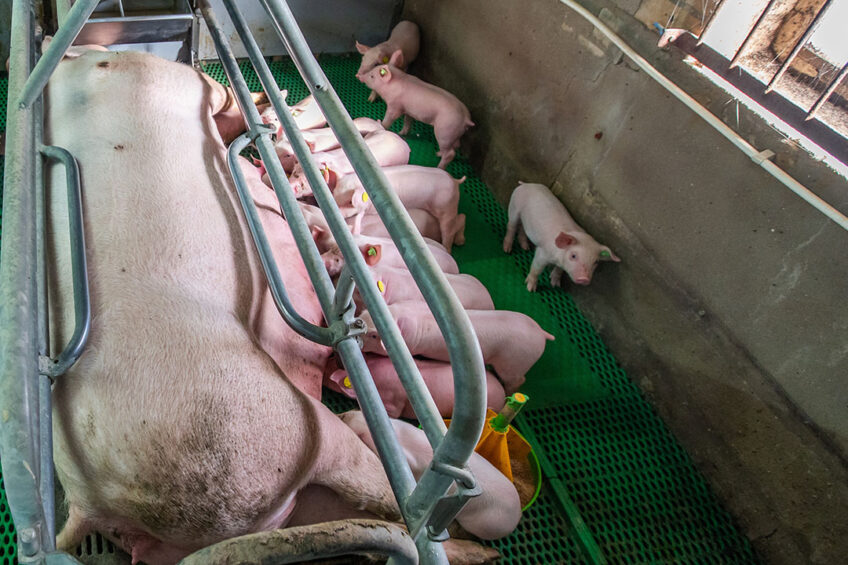
Litter size and numbers of weaned piglets from hyperprolific sows differ a lot. A reduction in young piglet mortality requires better sow feeding and management prior as well as post-farrowing.
The introduction of very prolific sow lines in herds has led to a faster increase in litter size than in the number of weaned piglets. The difference results from an increased mortality rate in the farrowing unit. Over the 115 days of gestation nutrient requirement for in-utero litter growth is very low. This explains why it is very difficult to influence the average birth weight per litter. However, daily requirements are not constant. This indicates that with hyper-prolific sows we are facing new challenges. This raises the question whether we can improve the survival rate through using different levels of nutrient supplies, different kinetics of supply over the gestation length, different type of nutrients or different ratios among nutrients?
Manage sow body condition at farrowing
During lactation, sows are often unable to eat enough feed to meet their requirements. The nutrient deficiency is then compensated by body reserve mobilisation. Milk production is not impaired as long as the initial level of body reserves at farrowing is high enough. When that is not the case, milk production can be compromised and piglets’ growth altered. The other extremity is that too fat sows should also be avoided. Those animals are more exposed to difficulties during parturition, with an increased proportion of still born piglets. In addition, the spontaneous feed intake during lactation is often reduced which impairs reproduction after weaning.
The optimal backfat thickness depends on the sow genotype but also on the characteristics of the farm (including the farmer). In cases where the feeding system in the farrowing unit and the know-how of the farmer allow a high level of feed intake during lactation, the target backfat thickness will be lesser than in conditions where feed intake is lower. Such factors explain why sows from a given genotype can present an optimum backfat thickness at the end of gestation equal to 21 mm or 16 mm. Yet, in a very heterogeneous herd at the end of gestation, even lower values are observed; indeed with a high heterogeneity, there is an increased proportion of sows with excessive body fatness. But the reduction of average backfat thickness target in heterogeneous herds increases the proportion of too thin sows that may have difficulties to express their milk potential.
In order to limit problems due both to too thin and too fat sows, the farmer is prompted to reduce the within-batch heterogeneity of sows, with regard to their backfat thickness, and to adapt the feed allowance to an expected optimum level for this criteria. Of course, feed allowance during gestation must also be adapted to parity, taking into account its effect on body weight and maintenance requirements.
Daily feed supplies during gestation
According to the individual body weight and backfat thickness measured at weaning or at the beginning of the gestation, and the expected body weight and backfat thickness at farrowing, it is possible to calculate both the energy and amino acid requirements of the gestating sows. For a long time, no difference was observed between performance obtained in herds with a constant feed supply over the total gestation and those fed with increased feeding allowance or with a U-shape plan. With hyper-prolific sows, this is no longer true, since requirements for the in-utero litter growth increases markedly over the last month of gestation. With constant feed allowance, a backfat loss is often observed at the end of gestation, in such conditions, which may contribute to the reduced vitality of piglets born from large litters. On the contrary, some recent trials have demonstrated that a marked increase of feed allowance over the two-three last weeks of gestation can contribute to improve piglet vitality (see Figure 1).
Figure 1 – Effect of the gestation feeding plan on the farrowing progress in litters of 15 piglets and more.
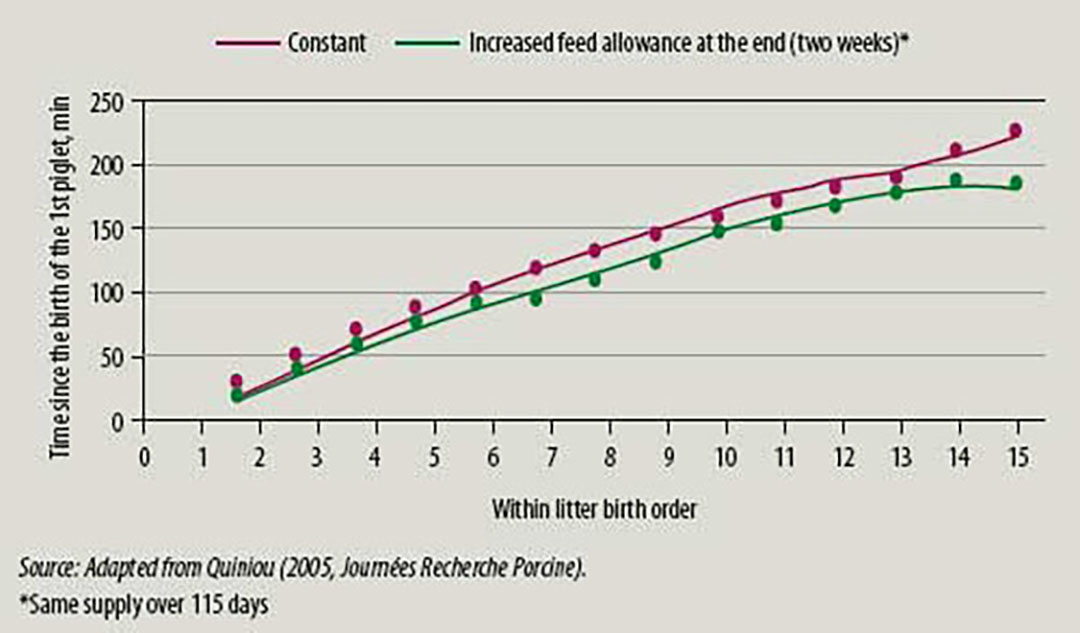
Whether it is a direct or an indirect effect is not presently clear, but one explanation comes from the enhanced sow’s tone at farrowing when overfed during the late gestation. However, attention must be paid to the fact that these sows must not receive more feed over the 115 days of gestation. The higher feed allowance at the end must be anticipated with lower feed allowance at the middle of the gestation. Thereafter, the 800 to 1000 g extra-feed allowance should be supplied in two days, to avoid any torsion or other accidents of abdominal organs. Some nutrients may probably play a more important role in the improved farrowing progress and piglet vitality than others.
Influence of nutrients in-utero
For a long time, it was considered that no transfer of lipids, e.g. fatty acids, occurred through the placenta. In fact, this transfer is very limited but still happens as several studies showed that the fatty acid profile of the newborn piglets reflects the fatty acid profile of the gestation diet.
Interest of the dietary fat incorporation in gestation diet on piglet vitality is still controversial, as it will depend on the initial survival rate in the herd, the duration and the amount of lipid supply before farrowing. When initial survival rate is low, two different mechanisms can be involved in improved vitality. When lipid supply begins from early gestation, then time is long enough to modify in-utero the characteristics of the foetuses toward increased body lipid and modified metabolism at birth. In this case, survival rate of low birth weight piglets is improved (Figure 2).
Figure 2 – Survival rate before weaning depending on the birth weight and the type of energy provided during gestation.
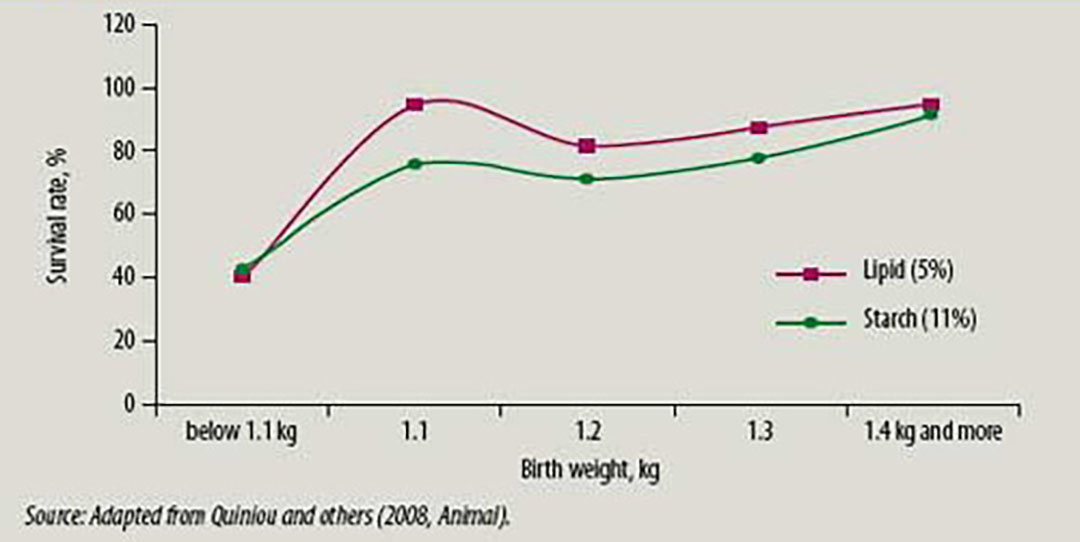
When lipid supply begins a few days before farrowing, one can expect only an effect on lipid content of colostrum. In case this supply occurs later, it can help to solve some digestive problems, like constipation involved into agalactia, through a soap effect of undigested lipids in the digestive tract. However, high fat diets are usually more concentrated in energy, and daily feed allowance should be adjusted so that total (net) energy supply is not increased, as the sow will be too fat at farrowing.
Key role for PUFA’s
Different sources of lipid have been investigated with regard to their polyunsaturated fatty acid content (PUFA). In literature, omega-3 PUFA has been demonstrated to play a key role in numerous physiological functions, such as the development of the nervous system, the fluidity of cell membranes, the synthesis of prostaglandins, which can be involved in the vitality and/or the health of newborn piglets. Results available on omega-3 PUFA supplied by fish oil indicate that the scheduled farrowing induction should be adapted; indeed the omega- 3 PUFA tends to extend the duration of gestation and premature farrowing is detrimental for survival rate. With extruded linseed incorporation, the farrowing progress is improved with shorter birth intervals that could explain a better survival rate until weaning, mainly in small piglets.
However, the benefit is probably due not only to the type of energy (lipid vs. starch), as no improvement was reported with an iso-energetic supply of palm oil (rich in saturated fatty acid). The fibrous compounds of extruded linseed could also contribute to the benefit in synergy with omega- 3 PUFA.
Increased energy in colostrum
When compared to a standard diet, increasing the energy content of the lactation diet increases energy intake of sows even if their daily feed intake is decreased. As energy provided through lipids is mainly transferred to mammary glands, sows fed diets fortified with lipids during lactation produce milk with a higher fat content. This may explain why in most cases the body weight and backfat losses over lactation are not reduced and reproductive performance is not improved in sows fed diets supplemented with fat. High lipid lactation diets that provide fatter milk, combined with creep feed rich in protein contribute to the increase of body weight of weaned piglets. Such a strategy appears to be interesting
during the summer, when warm conditions induce a reduction of milk production. In such circumstances, creep feed intake increases and combined with fat milk, it can help to maintain at least partly the weaning weight.
Feed allowance during lactation
Over the last 3 decades, the increased litter size has been associated with a higher milk output and consequently, increased nutritional needs. Simultaneously, the selection for reduced carcass fatness in growing pigs prevent an increase of appetite in sows, leading to a deterioration of the nutritional status of the sow during lactation and at weaning. The consequence of an excessive mobilisation of body reserve on post-weaning reproduction performance is known for a long time. More recently, evidence has been provided that it influences not only the weaning to oestrus interval or the conception rate but also the characteristics of follicles and potentially the birth weight heterogeneity. Presently, farmers are advised to increase the feed intake of their lactating sows toward a reduced mobilisation of body reserve (especially muscle) not only for the short term results but for the middle term ones, i.e. 118-120 days later.
Nowadays, in Brittany, the daily increase in feed supply after farrowing is performed more rapidly than 15 years ago (over the first ten days of lactation). In addition, the dietary level of amino acids in the lactation diet is more finely adjusted to the milk potential and the feed intake. The amount of nutrients exported in milk during lactation can be predicted from litter size and average daily gain, which allows a precise determination of daily energy, ileal digestible amino acids and mineral requirements. Thereafter, the knowledge of average feed intake allows the nutritionist to define optimum levels of dietary nutrient contents for a given herd.
A better control of ambient temperature also plays a key role in feed intake. One has to keep in mind that the lactating sow is continuously exposed to heat stress. Some adaptations occur as long as temperature remains below 25°C all day long, which helps to maintain milk production. But above this threshold temperature, strategies, such as lipid supply in the lactation diet, should be implemented to prevent a reduction of piglets’ ADG before weaning.
 Beheer
Beheer

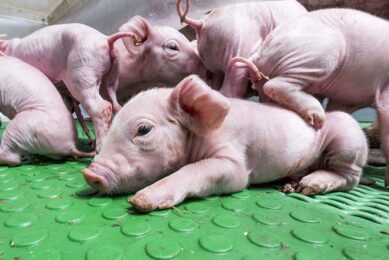
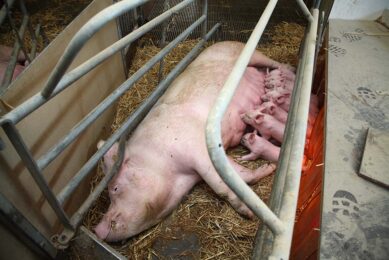
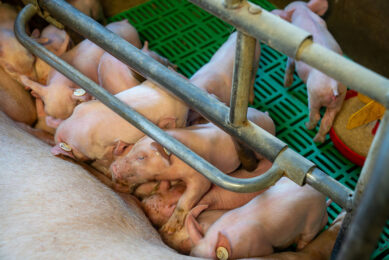
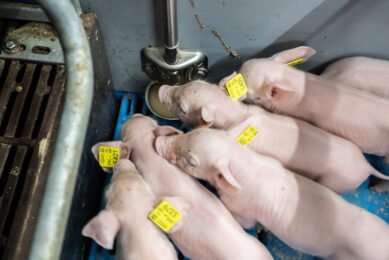
 WP Admin
WP Admin  Bewerk bericht
Bewerk bericht